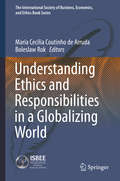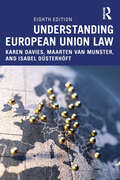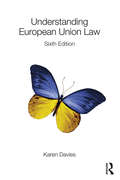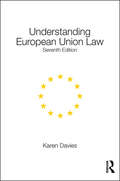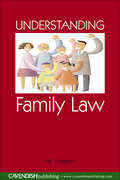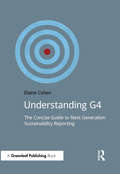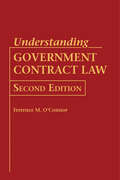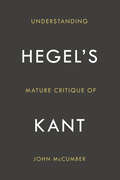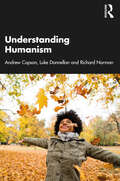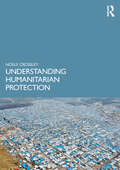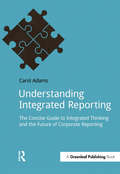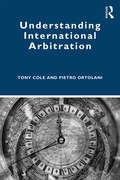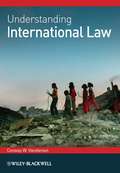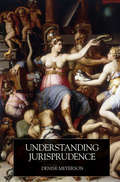- Table View
- List View
Understanding Ethics and Responsibilities in a Globalizing World
by Maria Cecilia Coutinho de Arruda Boleslaw RokThis book contemplates the ethics of responsibility in a large range of meanings, consequences and impacts. It reflects the perspectives and reasoning of 24 authors from all continents. All chapters are original papers presented at the Fifth World ISBEE Congress, that took place in Warsaw, Poland, at the Kozminski University, on 11-14 of July, 2012. In this book, ethics and responsibility are considered essential traits of character, not only in the business or governmental arenas but in any initiative, decision and activity. The contributions to this book focus on a spectrum of themes, terms and concepts, the global corporate social responsibilities perspective covering impacts, challenges, analysis, criticism, consequences of important topics of real life, sustainability, international economy and regimes, corruption, poverty and violence, among others. The book is intended for academics, researchers and professionals in all continents who are dedicated to Ethics, Business Ethics, Corporate Social Responsibility, Social Innovation, and Sustainability Management.
Understanding European Union Law
by Karen Davies Maarten van Munster Isabel DüsterhöftProviding short, clear and accessible explanations of the main areas of EU law, Understanding European Union Law is both an ideal introduction for students new to EU law and an essential addition to revision for the more accomplished. This eighth edition has been fully revised and updated with the latest legislative changes and includes an in-depth discussion of ‘Brexit’ and its implications for EU–UK relations. The book provides readers with a clear understanding of the structures and rationale behind EU law, explaining how and why the law has developed as it has. In addition to discussing the core areas of EU law such as its sources, the role and powers of the EU’s Institutions, the enforcement of EU law and the law of the internal market, this edition also includes a new chapter on three ‘non-economic’ areas of EU law: fundamental human rights, equality (non-discrimination) and the environment. This student-friendly text is both broad in scope and highly accessible. It will inspire students towards further study and show that understanding EU law can be an enjoyable and rewarding experience. As well as being essential reading for Law students, Understanding European Union Law is also suitable for students on other courses where basic knowledge of EU law is required or useful, such as business studies, political science, international relations or European studies programmes.
Understanding European Union Law
by Karen DaviesUnderstanding European Union Law is both an ideal introduction for students new to EU law and an essential addition to revision for the more accomplished. It is also indispensable reading for students on business studies courses. Fully revised and updated, this sixth edition continues to look at the main themes of EU law in a straightforward and logical manner. Updated to discuss the UK’s increasingly difficult relationship with the EU and recent developments in EU citizenship rights such as the Zambrano decision, this book provides the reader with a clear understanding of EU law, concentrating on how and why the law has developed as it has. A chapter on assessment guidance has been expanded to provide advice on revision, coursework and examinations on the subject of EU law. This student-friendly text is broad in scope and highly accessible, inspiring students toward further study and showing that understanding EU law can be an enjoyable and rewarding experience.
Understanding European Union Law
by Karen DaviesUnderstanding European Union Law is both an ideal introduction for students new to EU law and an essential addition to revision for the more accomplished. It is also indispensable reading for students on business studies courses. Fully revised and updated, this seventh edition continues to look at the main themes of EU law in a straightforward and logical manner. Updated to discuss the results of the 2016 EU Referedum and the possible impacts of 'Brexit', this book provides the reader with a clear understanding of EU law, concentrating on how and why the law has developed as it has. The section on competition law has also been expanded. This student-friendly text is broad in scope and highly accessible, inspiring students towards further study and showing that understanding EU law can be an enjoyable and rewarding experience.
Understanding Evidence
by Paul GiannelliThis Understanding treatise presents the essential topics in evidence law cogently and concisely. While it was written primarily for students in Evidence and Trial Practice courses, the Key Points summary at the end of each chapter and the inclusion of the current Federal Rules of Evidence in an appendix make this treatise an excellent reference for busy attorneys. Understanding Evidence begins with an overview of Evidence law followed by an explanation of the roles of the judge and jury. The remaining chapters are organized under the following topics:Procedural Framework of Trial Relevancy Witnesses Real and Demonstrative Evidence Writings Hearsay Privileges Substitutes for Evidence. This treatise extensively discusses and cites the Federal Rules of Evidence. Cases, statutes, other rules, and secondary sources are also cited, providing a comprehensive framework for understanding evidence law.
Understanding Evidence
by Paul GiannelliThis book is written for students in evidence and trial practice courses. The focus is on the Federal Rules of Evidence, which have been adopted in one form or another in over forty jurisdictions. Since the last edition, the Supreme Court adopted a number of amendments to the Federal Rules of Evidence. The major ones deal with hearsay issues relating to prior consistent statements and ancient documents. Another amendment concerns the self-authentication of electronic records. In addition, the Supreme Court further defined the parameters of the approach to Confrontation Clause jurisprudence that it embarked on in Crawford v. Washington. The new case is Ohio v. Clark (2015). Moreover, in Pena-Rodriguez v. Colorado (2017), the Supreme Court carved out an exception to Rule 606 based on constitutional grounds: " [W]here a juror makes a clear statement that indicates he or she relied on racial stereotypes or animus to convict a criminal defendant, the Sixth Amendment requires that the no-impeachment rule give way in order to permit the trial court to consider the evidence of the juror's statement and any resulting denial of the jury trial guarantee." In 45 years of teaching, one's debt to past scholars is immense. Morgan, Wignore, McCormick, Ladd, and Maguire immediately come to mind. The debt is no less to current scholars: Weinstein, Berger, Inwinkelried, Broun, Mosteller, Nance, Park, Mueller, Kirk-patrick, Ken Graham, and Michael Graham, to name but a few.
Understanding FIDIC: The Rainbow Suite (Understanding Construction)
by Kelvin HughesUnderstanding FIDIC explains in simple and practical terms what is often seen as a very complex range of international engineering and construction contracts. Covering the FIDIC 2017 Red, Yellow and Silver Books (referred to as "The Rainbow Suite"), the book gives an overview of all three contracts, including coverage of changes between the 1999 contracts and the present 2017 suite. FIDIC contracts are widely used as far afield as Europe, the Middle East, Asia and Australia, and this book provides a practical yet thorough guide to the key elements that practitioners preparing and administering these contracts would need to be aware of. In his approachable and readable style, Kelvin Hughes covers: The obligations and responsibilities of the Employer, the Employer’s Representative, the Engineer and the Contractor Quality and Defects Liability Design Responsibility and Liability Variations, Measurement and Payment Procedures Progress, Delays, Extensions of Time and Completion Suspension and Termination Insurances Employer’s and Contractor’s Claims The Dispute Avoidance/Adjudication Board and the Resolution of Disputes Tendering Anyone working with FIDIC contracts whether as the Employer, Employer’s Representative, Engineer or Contractor will benefit greatly from this easy-to-read guide to the Rainbow Suite. Students on professional courses or researching the contracts for project work will also find this book extremely useful.
Understanding Family Law
by Liz RodgersUnderstanding Family Law is a clear and concise book for students of family law. The text is easy to digest, and even the most complex issues are presented in a user-friendly way.
Understanding Forfeitures
by Noreen Clancy Amy RichardsonThe Treasury Executive Office for Asset Forfeiture (TEOAF) administers the Treasury Forfeiture Fund (TFF), which receives deposits of nontax forfeitures made by current and former Treasury agencies. Participating agencies use TFF funds to disrupt and dismantle criminal enterprises. This report examines the relationship between targeted funding support of major financial investigations and the forfeiture outcomes of such investigations.
Understanding G4: The Concise Guide to Next Generation Sustainability Reporting (Doshorts Ser.)
by Elaine CohenShould you or your clients report using the new G4 sustainability reporting framework? What's the significance of the changes and how do they affect you? What is the right reporting level for your company? What should you do next...?Sustainability reporting is here to stay and expanding its influence. The Global Reporting Initiative (GRI) G4 Sustainability Reporting Framework was launched in May 2013, with the publication of two manuals, adding up to 300 pages of technical guidance. Since then thousands of reporters have been hoping for a short and definitive guide to this new reporting paradigm. This is it!In this expert guide to G4, Elaine Cohen presents an easy-to-follow review of everything any company needs to know in order to decide whether to use the G4 Framework and if so, how. If you want to know what G4 means for corporate reporters, whether they are first-timers, SMEs, experienced global companies or existing GRI reporters at any level, this book is for you. It will give you the answers you need to make decisions, in a user-friendly format, and help you deliver greater value to your own company or your client companies.This book will also help users of reports know what to expect from the new generation of G4 Sustainability Reports and reporting consultants, as they advise clients on reporting process, content and disclosure.
Understanding German Real Estate Markets
by Wolfgang Maennig Tobias JustIn this book, experts discuss how German real estate values have remained stable throughout the financial crisis, even though transaction volumes have been very volatile since 2005. Consequently, risk-averse national and international investors have started to invest in virtually all German real estate asset classes. This book tries to answer what has made the German real estate markets more resilient to shocks than many European real estate markets by analyzing the economic, regulatory and demographic environment. In 30 well-structured chapters, experts from both the academic and professional world analyze structural and current issues of German real estate markets. Readers will get a deep understanding of what makes the German real estate market special and where potential opportunities and threats in Europe's largest real estate market exist.
Understanding Global Conflict and Cooperation: An Introduction to Theory and History (Ninth Edition)
by Joseph S. Nye David A. WelchA concise and penetrating introduction to world politics in an era of complex interdependence, this book aims to introduce students to the complexities of international politics by giving them a good grounding in traditional realist theory before turning to liberal and constructivist approaches that have become more prominent after the Cold War. This text employs lessons from theory and history to examine conflict and cooperating among global actors and thus to provide readers with a durable analytical framework.
Understanding Government Contract Law
by Terrence M. O'ConnorThis updated classic offers clear and concise explanations of the basic legal concepts of government contract law for professionals at any stage of their career. Written in straightforward language for contracting officers, contract administrators, contractors, subcontractors, and others in the procurement field, this new edition has been updated with new cases and regulations. The book breaks down the complex arena of government contract law into its three most basic parts: the contracting parties, the contract itself, and legal challenges. It begins by examining key aspects of the contracting officer's job and provides guidance for navigating its different and often conflicting demands. The government contractor's responsibilities and challenges are also outlined. Government contracts come in a lot more varieties than the typical commercial contract, and they also tend to be long and confusing. The second part of the book introduces the different types of legal agreements the government uses to buy the goods and services it needs—and addresses the challenges of writing a perfectly clear contract and guidelines for interpreting an ambiguous one. The book concludes with an overview of the government contract litigation process.This is an essential text for students preparing to do the work of government contracts, an indispensable guide for those new to the work, and a valuable reference for contracting personnel who seek solutions to specific issues they face in their day-to-day work.
Understanding Government Contract Law
by Terrence M. O'ConnorA "back-to-basics" guide to government contract lawFinally! A plain-English presentation of the basic legal concepts of government contract law for professionals at any stage in their careers.Until now, anyone in the procurement field has had to trudge through dense and complex texts written in hard-to-follow "legalese" in their quest to understand procurement law. With Understanding Government Contract Law, they finally have a source of clear and concise explanations of the legal principles involved in government contract law, written by an authority on the subject.Part I of the book focuses on the unique problems facing each of the parties to a government contract – the contract officer and the contractor – and offers insight to the many roles played by the contract officer in the procurement process. Part II describes why and how the government contract is different from commercial contracts. Part III explores the ins and outs of a government contract lawsuit.The author presents key legal principles of government contract law by:• Stating a legal principle• Specifying where in the Federal Acquisition Regulation (FAR) that principle is found• Offering the rationale, context, and any public policy behind the principle• Describing, with case law examples, situations where the government applied the law correctly and situations where the government came to that conclusion incorrectly
Understanding Hegel's Mature Critique of Kant
by John MccumberHegels critique of Kant was a turning point in the history of philosophy: for the first time, the concrete, situated, and in certain senses "naturalistic" style pioneered by Hegel confronted the thin, universalistic, and argumentatively purified style of philosophy that had found its most rigorous expression in Kant. The controversy has hardly died away: it virtually haunts contemporary philosophy from epistemology to ethical theory. Yet if this book is right, the full import of Hegels critique of Kant has not been understood. Working from Hegels mature texts (after 1807) and reading them in light of an overall interpretation of Hegels project as a linguistic, "definitional" system, the book offers major reinterpretations of Hegels views: The Kantian thing-in-itself is not denied but relocated as a temporal aspect of our experience. Hegels linguistic idealism is understood in terms of his realistic view of sensation. Instead of claiming that Kants categorical imperative is too empty to provide concrete moral guidance, Hegel praises its emptiness as the foundation for a diverse society.
Understanding Hospitality Law Fifth Edition
by Jack P. Jefferies Banks BrownUnderstanding Hospitality Law alerts hotel and restaurant operators to a number of potential legal problems and pitfalls. Readers of Understanding Hospitality Law should be better able to recognize, early on, a legal problem or potential legal problem, so they can consult with a local attorney in time to head off the problem before it mushrooms into a damaging lawsuit. At the end of each chapter, the reader will find "Important Points for Management," a section that summarizes the basic legal principles discussed in the chapter.
Understanding Humanism
by Richard Norman Andrew Copson Luke DonnellanUnderstanding Humanism is an easy-to-read and informative overview of the beliefs, practices, and values of humanism as a non-religious worldview. This short and lively book explores humanism both as a broad historical tradition of thought and as a stance embodied in organised institutions. It sets out clearly and systematically the beliefs and values of humanism as well as the reality and personal experience of living as a humanist today. Questions discussed in this book include: How do humanists see the relation between science and religious belief? Is humanism wedded to science as the only valid form of knowledge? What value do humanists place on the arts, and can they value religious art? Does the emphasis on human responsibility depend on an untenable belief in 'free will', and is this undermined by psychology and neuroscience? Do humanists think that life is sacred? What account would humanists give of the basis of human rights, and why they are important? Does humanism entail that human life is meaningless and pointless? Can humanists meet the challenge of nihilism? Understanding Humanism provides a reliable and easily digestible introduction to the field. By exploring these questions and inviting readers to engage with the arguments, it serves as the ideal textbook for those approaching the topic of humanism for the first time.
Understanding Humanitarian Protection
by Noele CrossleyThis new textbook provides an introduction to humanitarian protection, a field of study concerned with international responses to armed conflict, political violence, and humanitarian crisis. The book engages with a wide range of empirical and normative questions, providing an overview of the academic literature whilst simultaneously discussing the policies and practices associated with protective responses to conflict and humanitarian emergencies that put the lives and livelihoods of vulnerable populations, including civilians, refugees, and minority groups, at risk. Divided into three parts, covering the origins of the humanitarian protection regime, the range of actors involved, and the responsibilities of these actors, the book offers an accessible entry point into the major contemporary debates, providing readers with the conceptual tools for understanding core issues. Key points are reinforced and illustrated through the deployment of selected case studies, and a comprehensive glossary is provided for key terms. Each chapter ends with a summary of key points, questions for further reflection, and a list of recommended reading. This book will be of much interest to students of human protection, humanitarianism, the Responsibility to Protect, human security, peacekeeping, and International Relations in general.
Understanding Immigration Law
by Raquel AldanaUnderstanding Immigration Law lays out the basics of U. S. immigration law in an accessible way to newcomers to the field. It offers background about the intellectual, historical, and constitutional foundations of U. S. immigration law. The book also identifies the factors that have historically fueled migration to the United States, including the economic pull of jobs and family in the United States and the push of economic hardship, political instability, and other facts of life in the sending country. In the middle chapters, the authors provide a capsule summary of the law concerning the admissions and removal procedures and criteria in the Immigration and Nationality Act. The book ends with a chapter speculating about the future of U. S. immigration law and the challenges and opportunities facing the nation.
Understanding Institutional Shareholder Activism: A Comparative Study of the UK and China (Routledge Research in Corporate Law)
by Bo GongInstitutional shareholder participation has long been considered as vital to good corporate governance yet its potential does not seem to have been realized. The recent banking crisis exposed the passivity of some institutional shareholders, many of whom appear to have chosen to sell their stakes in the banks rather than intervene or challenge the board when they realized the strategies followed by the banks were excessively risky. Institutional shareholders’ role to scrutinize and monitor the decisions of boards and executive management in the banking sector in the UK is considered by many to be a failure, resulting in the phenomenon of ‘ownerless corporations’, as described by Lord Myners. In China, despite the fast rising of institutional investment in the securities market, institutional shareholders have not yet played a contributory role in monitoring corporate managers in listed companies. Drawing on empirical evidence this book seeks to systematically analyses institutional shareholders’ incentives to activism to explain when and why shareholder activism will occur. The book puts forward a model which explains the factors that determine institutional shareholders’ propensity for activism. The model both elaborates the collective benefits of activism as a means of achieving managerial accountability asks whether and when shareholder activism is rational for any individual shareholder. The book then goes to on to apply these finding to both the UK and China in order to explain the varying levels of shareholder activism in each jurisdiction. The book is the first to take an in-depth look at institutional share-holder activism in China providing prescriptions to promote greater shareholder engagement and exploring the potential it holds for improving corporate governance in the region.
Understanding Integrated Reporting: The Concise Guide to Integrated Thinking and the Future of Corporate Reporting
by Carol AdamsIntegrated Reporting is the big new development in corporate reporting that everyone is talking about. Why? Quite simply, Integrated Reporting marks a paradigm shift in the way companies and other organizations think about business models and the creation of value. Integrated Reporting promotes long term thinking about value-creation and stewardship across a broad base of interdependent capitals – financial, manufactured, human, intellectual, natural, and social and relationship.With updated references and case studies to take account of the latest developments in Integrated Reporting, this book provides a practical and expert distillation of for IR professionals.Internationally renowned sustainability reporting expert and accountant Dr Carol Adams explains in simple terms what is and how to do it; how it links with other reporting frameworks and what it means in terms of thinking and processes. You'll also get a clear business case for IR and insights and best practice examples from leading integrated reporters. Integrated Reporting is not just for companies.This book demonstrates how integrated thinking and IR can benefit many other organizations whose success and influence depends on relationships and partnerships.
Understanding International Arbitration
by Tony Cole Pietro OrtolaniUnderstanding International Arbitration introduces students to the primary concepts necessary for an understanding of arbitration, making use of illustrative case examples and references to legal practice throughout. This text offers a comprehensive overview of the subject for those new to arbitration. Making use of a unique two-part structure in each chapter, Understanding International Arbitration provides a clear and simple statement of rules, followed by detailed discussion of the ideas underlying those rules, illustrated with relevant comparative law and case examples. Designed with students of arbitration in mind, this text provides both a clear introduction to the subject and a comprehensive course text that will support students in their preparation for exams and practical assessments.
Understanding International Conflicts: An Introduction to Theory and History
by Joseph S. NyePlaces international conflict within the larger context of political economy
Understanding International Law
by Conway W. HendersonUnderstanding International Law presents a comprehensive, accessible introduction to the various aspects of international law while addressing its interrelationship with world politics. Presents well-organized, balanced coverage of all aspects of international law Features an accompanying website with direct access to court cases and study and discussion questions. Visit the site at: www.wiley.com/go/internationallaw Includes discussion of the efficacy of international law, a topic unique among international law texts Offers discussion of other topics that most texts do not address, such as complete chapters on making the world safer, human rights, the environment, and the world economy.
Understanding Jurisprudence
by Denise MeyersonConsidering general philosophical and theoretical questions about the nature, purpose and operation of law as a whole, this book introduces students to contemporary debates in jurisprudence and encourages them to think in a theoretical and critical way about the nature of law, legal reasoning and adjudication. Discussing wider issues of morality, politics and society with reference to legal cases and examples, it provides as broad a perspective on the law as possible. Key features of this textbook include: introductions to each chapter analysis of how jurisprudential issues can arise in everyday life a wide range of cases to ground the theoretical discussion in-depth discussion of the relationship of law to force, morality and politics, as well as of rights, justice and feminist jurisprudence. The text provides a concise treatment of all the major topics typically covered in an undergraduate course on jurisprudence and succinctly explains the arguments for and against the different approaches to the issues that are raised.
